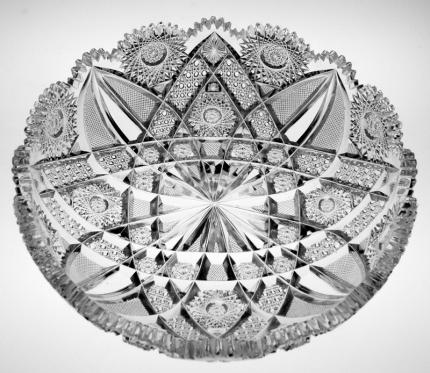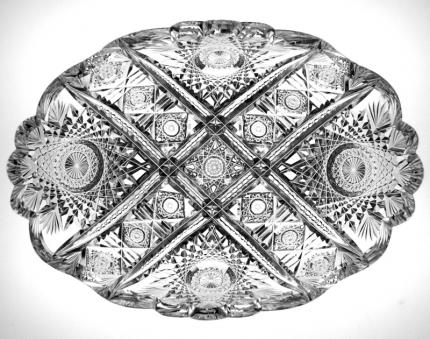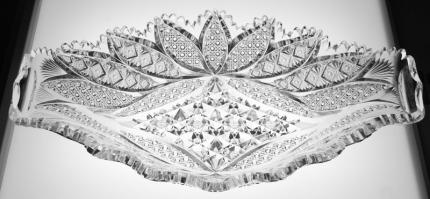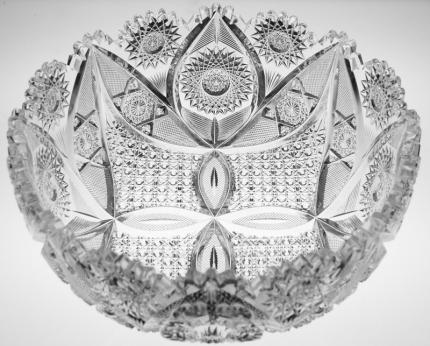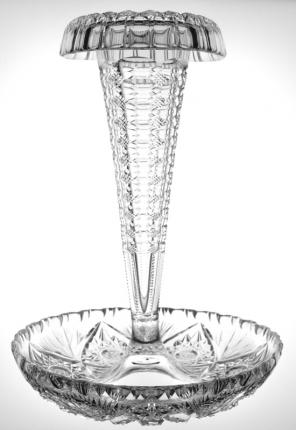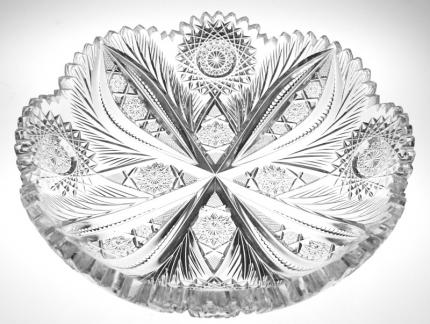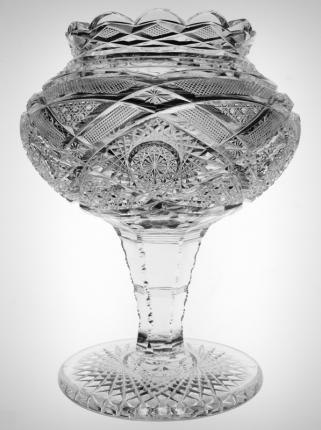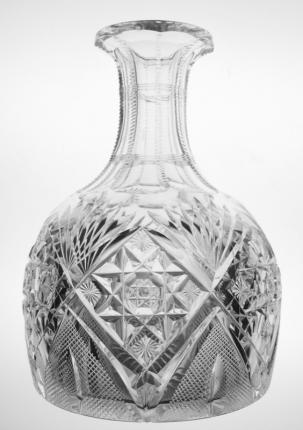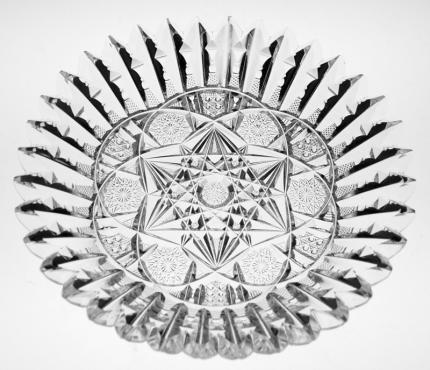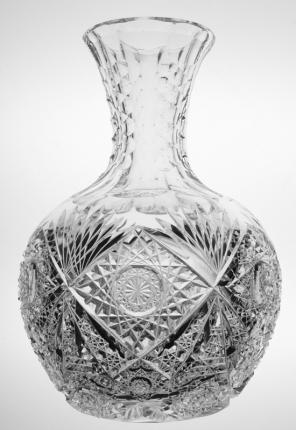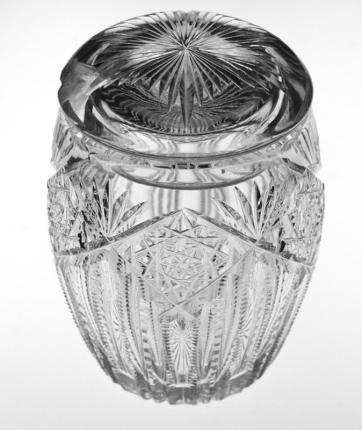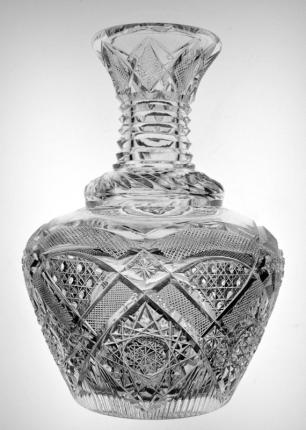The Eleanor pattern is easily one of my favorites. While it’s very similar to Hoare’s Carolyn, it’s an entirely different animal. The cutting is far more precise and perfectly polished and the blanks are always crisp, blown and clear. I also believe Eleanor is an earlier pattern as I’ve never seen a signed piece.
Cane provides the main framework for the pattern – housing hobstars topped with fields of fan cutting. Smaller hobstars connect the rest of the pattern together at the base of the cane. One of the main draws of the pattern is the vesica featuring a clear tusk (one of the most difficult motifs to cut) which look like gorgeous, clear icicles placed within the busy pattern. These tusks extend and pierce the center of the bowl. Rich, sharp hobstars sit between each point of the pattern at the edge.
The bowl is in excellent condition with one tooth having a small flake at the edge. The blank is spectacular and the cutting couldn’t be better. It measures 8″ wide and ” tall.
This bread tray or fruit bowl is cut in an unknown pattern by Hawkes. It’s very unusual in both the rim treatment and use of hobstars, fans, and framing. It’s signed in the center with the Hawkes logo.
Two crossing chains of hobstars makeup the framework of this design. The hobstars are separated by triple-miter segments and surrounded on either side by notching. Four huge, richly cut hobstars make up the rest of the pattern. On the underside, the hobstars are contained by deep miters while on the top, they’re topped with fans and three huge, curvy teeth. It’s really unusual and shows some classic and more progressive stylings from Hawkes.
The tray is in perfect condition and measures 10 1/2″ long, 7 1/4″, and 3 1/4 tall. The blank is thick, heavy and quite clear which showcases the dynamic cutting perfectly.
This piece is easily the best fishtail tray I’ve ever seen. Cut in Hawkes’ Olympia pattern, the exact piece is shown in the ACGA catalog reprint on page 105. It is signed with the Hawkes trademark in the center of the piece.
The Olympia pattern starts with a complex cluster of hobstars and crosshatching seperated by deeper miters at various angles. The center cutting is flanked on all four sides in diamond formation by cane cutting. The perimeter of the pattern is made up of what looks like plumes of feathers/vesicas. Note in the third photo that the blank of the tray actually crimps with the vesicas. Grouped together are “feathers” of cane or chains of hobstars. The ends of the tray come to a point and have handles cut into the blank.
The blank, like you would expect on a piece of this quality, is gorgeous-clear and radiant. The tray measures 16 1/2″ long, 9 1/2″ wide and 3 1/4″ high. Fishtail trays are always popular and usually cut well, but this one blows them all out of the water (pun intended). This is a rare opportunity to own one of the bests.
This straight-sided bowl, cut in Monroe’s Sunburst design, is a spectacular example of what the company was able to achieve when firing on all cylinders. The design is a masterpiece in use of unusual motifs. Just look at those large fields of cane (which is a completely different arrangement than most cane in cut glass).
The Sunburst pattern starts out with four split-vesica loops of crosshatching in propeller formation. Surrounding these vesicas is a very complex cane cutting. Rather than simply repeating traditional cane cutting throughout the field, Monroe spaces the motif in an and completely transforms the more common motif – there is an extra row of bars setup in almost a burst. The outer portion of the Sunburst pattern features a deep hobstar surrounded on either side by a parallel line frame which gives the hobstar the appearance of a flower. This same technique is used on Meriden’s Theodora. Separating the cane and hobstar cutting are large vesicas with crosshatching and a central, flat hobstar.
This stunning piece is in perfect condition and measures 9″ wide and 3 1/2″ high. The blank is supremely clear with no waviness, discoloration or imperfections. This is a terrific design and impeccably executed.
This is an extremely rare one-piece epergne with a jack-in-the-pulpit vase. The top, vase portion of this epergne is cut in Anderson’s Elegant pattern (which they cut on a jack-in-the-pulpit type vase). This type of cutting is extremely similar to Pairpoint’s Savoy. The bottom bowl of the epergne is cut in a pattern very close to Pairpoint’s Uncatena.
The top half of this piece is cut with clear punties separated by crossed miters. There is an additional notch connecting the punties which is a technique used almost exclusively by William C. Anderson. They continued the pattern on the rollover portion of the rim – a really nice extra touch. The bowl of the epergne is covered with 20-point hobstars. Each hobstars top and bottom points are filled with crosshatching-another Anderson technique. Each hobstar is separated by large fans of varying depth and width.
The epergne is on a beautiful blank and measures . It’s in great condition with only some minor roughness to the edge. This would make a beautiful centerpiece or display excellently on a shelf or cabinet.
This is a gorgeous bowl in what has been dubbed the Gemini pattern by the Anderson Study Group. It’s believed that William C. Anderson’s American Cut Glass Company produced the piece to their very high standards.
Four 20-point hobstars lie on the outskirts of the bowl perched atop a flat hobstar with crosshatching on either side. Dividing each hobstar is a vesica surrounded by feathered cutting for which Anderson is so well known. Each vesica is framed with notched cutting around three more flat hobstars with crosshatching. These extend from the edge of the bowl to the very center. It’s a beautifully symmetrical pattern.
The bowl is in perfect condition – I don’t even see a fleabite. It measures 9″ wide and 2″ tall. The blank is of the quality you expect from the American Cut Glass Company and the cutting dazzles with the all light of the prismatic spectrum.
This is an extrmelely rare form cut in Elmira’s No. 17 pattern. I love the pattern in that it perpetually loops around with bands of crosshatching. The piece is quite large and very heavy due to the thick neck, base and bulbous top.
The No. 17 pattern features loops of crosshatching tied together with square portion of fan. The looping ribbons of crosshatching frame both cane cutting and large hobstars. The rim of the piece features step cutting and an unusual diamond, crosshatched field cutting. The neck of the flower center is fluted and notched and the base is covered with a gorgeous 32-point hobstar!
This piece is in excellent condition with only a few small flakes in the cutting. The blank is wonderfully clear and measures 10 1/4″ tall and 8″ wide. Again, it’s heavy and substantial – a lot of glass too this piece.
This is a great looking, flat-bottomed ship’s carafe in Hawkes beautiful and old Venetian pattern. The entire piece is beautifully wood-wheel polished.
The outer layer of the Venetian contains a chain of 8-point hobstars. Each hobstar has a field of fans in between it’s point and a smaller, clear-button 8-point hobstar on the interior. Fans lie in between each of the larger stars. The center and signature portion of the pattern is made up for 6-looped split-vesicas with the finest of crosshatching. The neck of the carafe is fluted and notched and hte base is finished with a rayed star.
This gorgeous, early piece of brilliant cut glass measures and is in perfect conditon.
This plate is cut in Libbey’s popular and desirable Ellsmere pattern. It is signed in the center with the Libbey tradmark.
A flat hobstar is flanked on either side by two bands of triple-miter cane. This main portion of the pattern is encircled in what looks like partial circles-something I imagine wasn’t particularly easy to execute. Rising from this area is fine crosshatching met with deeply cut notched prism which creates the an extremely tasteful border. The center of the plate has a complex 6-point hobstar formation.
The plate is on an excellent blank and measures 6 3/4″ wide and 1 1/4″ tall. It’s in perfect condition. I should also mention that 6 3/4″ is the standard size for these plates, which most other companies cut pieces closer to 7″, Libbey seemed to cut this blank 1/4″ short on both the 7″ and 12″ sizes – it’s is not repaired.
This is one of the best carafes I’ve ever seen. Cut in Hawkes’ extremely desirable Kensington pattern, it is highly detailed from top to bottom. It is signed with the Hawkes’ trademark on the base.
The Kensington pattern is incredibly cut on this piece. Large hobstars surround the widest portion of the piece. Underneath each is a triangular field of Hawkes’ Kohinoor cutting. Each triangle intersects at a tiny richly cut hobstar. Coming up from the base is a graduating chain of hobstars separated by triple mitre cutting. The neck of this carafe is extremely impressive – it alternates with flut cutting and hollow diamond. It’s astonishing how much precious work went into this one piece.
The carafe measures 8 1/2″ tall and 6″ wide. It is in nearly perfect condition with only a few tiny nips to the cutting. The blank is outstanding and the meticulous pattern shines beautifully.
Small pieces like this are quite rare as many of the American companies imported foreign pieces to sell for their lines. This mustard jar is cut in J. Hoare’s Hindoo pattern.
The Hindoo pattern runs down the side of the jar starting with large hobstars and fans. The rest of the pattern is comprised of deeply cut scallops divided by deep notching and shallower zipper cutting. Both the base and top of the jar are finished with a rayed star. The lid also has a slot for a serving spoon.
Again, small American pieces like this are rare and difficult to come by. The jar measures 3 3/4″ tall and 2 3/4″ wide. It’s in perfect condition.
This carafe is cut in Emira’s impressive No. 17 pattern. This blank is quite unusual with its neck bulge and tapered sides and I’ve only ever seen it featured in a Bergen catalog.
The No. 17 pattern features loops of crosshatching tied together with square portion of fan. The looping ribbons of crosshatching frame both cane cutting and large hobstars. The lower portion of the carafe has unusual parallel line cutting while the neck features swril cutting along with step and crosshatching – really a touch of extra quality.
The blank of the carafe is heavy and clear and the piece is in perfect condition – with only one minor fleabite in the cutting. This large carafe measures 8 3/4″ high and 6″ diameter.

